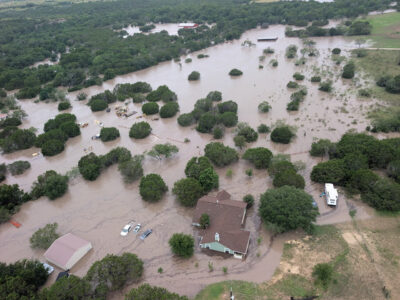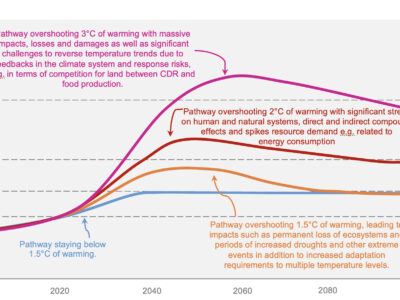One of the most difficult things about the COVID era is not knowing anything for certain. At first, no one knew the great reach of the virus, how exactly it spread, or how many would die. Twelve months in, we are still fuzzy on the details. In a world of loud talkers that is starved of true leadership, where do we as individuals turn for information and reliable answers?
The director of the National Center for Disaster Preparedness at Columbia University’s Earth Institute, Jeffrey Schlegelmilch, agrees that managing the unknown is indeed uncomfortable. But his advice differs from most experts. Rather than leading us down one path with extremist conviction, he suggests instead that we lean into our uncertainty. I spoke with him by Zoom to discuss managing our new world of unknowns in the current pandemic.

“Our tendency is to reject uncertainty,” Schlegelmilch told me. “We want answers, a checklist, a pill, a vaccine, something discrete and simple to solve these problems.”
It’s true—we all want fast answers and fast solutions, especially when dealing with the unknown. Not only is this virus a moving target, with lots of unexplained medical impacts, but also our understanding of it is so limited it feels overwhelming.
“Instead we need to build systems that focus on the ranges of things that could happen, and to build options that can be employed as more information is available,” said Schlegelmilch, “This is a different mindset with different questions than we are used to asking, but will build stronger resilience to the challenges we face.”
In his recently published book on preparedness, Rethinking Readiness: A Brief Guide to Twenty-First-Century Megadisasters, Schlegelmilch guides the reader through the five major disaster scenarios: biothreats, climate change, critical infrastructure failure, cyberthreats, and nuclear conflict. The book is refreshingly direct in its dealing with global threats and vulnerabilities. Surprisingly, Schlegelmilch wrote Rethinking Readiness before the pandemic. Another indication on how he landed in one the most prestigious positions in his field—he was prepared.

Schlegelmilch has spent his entire career preparing for the troubling global catastrophes many of us avoid thinking about. His experience spans roles in epidemiology, emergency planning, pandemic planning, disaster preparedness policy—and yet, his undergraduate path to preparedness wasn’t through memorizing statistics and probable outcomes. Surprisingly, Schlegelmilch was a theater major.
Raised in the Bay Area in California, Schlegelmilch majored in theater studies at DePaul University for his undergraduate degree. While theater seems an unlikely match for a disaster preparedness expert, there are some parallels. Both involve writing a plan or script, having clearly defined roles, team work, set-building, and of course improvisational elements. One of his favorite classes was about globalization with playwright and poet Ntozake Shange, who wrote the play ‘For Colored Girls Who Have Considered Suicide When the Rainbow Is Enuf’ and was a guest professor at DePaul.

“We were also studying social issues in works written about marginalized populations by writers such as Cornel West, and Homi Bhabha, and bell hooks, and just all of this wide cultural awakening,” Schlegelmilch told me. For Schlegelmilch, theater was an exploration of the complexities of life.
In the midst of this awakening, his third year was marked by 9/11. The extraordinary national tragedy combined with “the complexity of the world revealing itself” solidified Schlegelmilch’s preparedness trajectory. “I became interested in international health, global health, and this new world of bioterrorism and homeland security,” he said.
Schlegelmilch wanted to find out how he could “contribute to broader society in a meaningful way,” so after completing his fine-arts degree and with a minor in sociology, he went on to complete his MPH and MBA (Master of Public Health and Business Administration, respectively). He completed his undergraduate and initial graduate schooling all while working at Starbucks, which provided its own lessons in management and working with people from various backgrounds.
Preparing for unknown threats combined with unpredictable human reactions is a complex feat. When it came to the US response to the coronavirus, there were many factors at play, not to mention a contentious political climate that impeded the response from the beginning.
“In terms of activating the plans nationally, [it] was just kind of one misstep after another,” said Schlegelmilch. He’s disappointed that the federal government has left much of the decision-making up to states, and for its impatience to get things back to normal. “There’s this expectation that it’ll be gone in a couple of months, and it also doesn’t help when you have such inconsistent messaging coming along as well, too.”

The messaging from the government ranges from inconsistent to often erroneous and is proliferated globally by for-profit news media outlets. This misinformation crisis is unique—unfolding during an election year in a culture of highly divisive politics, when the intricacy of this pandemic requires media to interpret complicated medical science for a general audience. For example, in April, models and forecasts showed wildly different projections for what might happen next. These discrepancies left some of the public not only confused, but distrustful of media and the medical forecast models.
But to Schlegelmilch, the models aren’t there as an all-knowing oracle; rather they are tools to gather insight and prepare for a multitude of scenarios. He sees the larger picture in these models and encourages us to do the same. Rather than looking for one exact answer, we should search for multiple potential outcomes.
“If you step back from the idea of precision, or the idea that a model’s usefulness is only in the precise numbers that it spit out, and instead look for the trends that these numbers suggest in terms of what is working to stop the spread of the virus, you now have a tool that offers many more solutions than one numerical answer. Models are good for gaming out the consequences of different decisions. By analyzing these various trends, you can reduce the transmission by making incremental changes in our behavior patterns by implementing these immediately. That’s incredibly powerful.”
But looking for trends again asks us to accept a moving target. Schlegelmilch’s suggestion, not unlike his uncertainty principle, is to work down the middle of an issue, with each side expanding the scope of their positions and assumptions. “What are the boundaries of your uncertainty?” he then asks, drawing on lessons from The Strategy Paradox, a book by Michael Raynor.
The next step is to “create options for different ways that it might play out. Rather than trying to force certainty where it doesn’t exist, or rather than trying to cram more and more information for an answer that continues to be elusive, is instead to take that energy and devote it to creating different options in our response.”
There are other ways we can improve our current situation, beyond models and masks. Schlegelmilch says that another really important variable that is often overlooked in ideal outcomes is social capital. “[N]eighbors helping neighbors is one of the strongest predictors of how people do after a disaster. Things like social capital and social cohesion are undervalued.”
As a journalist, my aim is to discover essential threads to be digested by a general audience, so leaving my interview with an overarching theme of ‘uncertainty’ wasn’t entirely what I hoped for—at least, not at first. But the more I went over my notes, the more “leaning into uncertainty” became a gift—if one is to act on the uncertainty and create more and better options for themselves. Suddenly disaster preparedness gets very Darwinian; it is in our options that we increase our chances of survival, not in our allegiance to one set of ideas.
As Schlegelmilch says: “The catastrophes we face are growing more complex, but at the same time, we also have access to more perspectives and more resources to face that complexity.”
Journalist Debra Winter wrote this profile as part of her work in the Sustainability Management course, “Writing About Global Science for the International Media.”



